Observable Indicators of Quality Nursing Homes
Dr. Marilyn Rantz and colleagues at the University of Missouri identified six dimensions of quality for nursing homes: Home, Staff, Communication, Care, Family Involvement, and Environment.
Tour the nursing home below to learn about these dimensions in practice. Click the arrow on the side of the image to navigate the tour.
Home
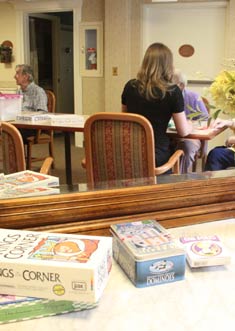
Residents engaged in activities
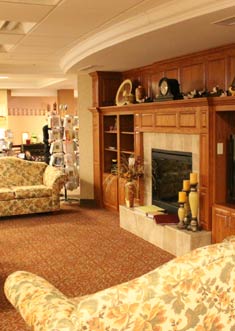
A de-institutionalized setting
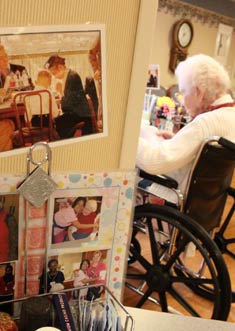
A setting personalized to the residents
We all have our own perspectives of what ‘home’ means to us. What people desire when they move into a nursing home is the ability to continue to live their lives as they did before. Think about what you like to do in the morning when you get out of bed. Maybe you have to have that cup of coffee, or you take some time to read the newspaper. A current movement is the transformation of nursing homes from ‘institutions’ to ‘homes.’ Of course, the sense of home is most important to those who are planning to stay in the nursing home for the remainder of their lives, not to those admitted to a nursing home for short-term care. However, even those who are staying a short time desire the amenities of home.
Environment
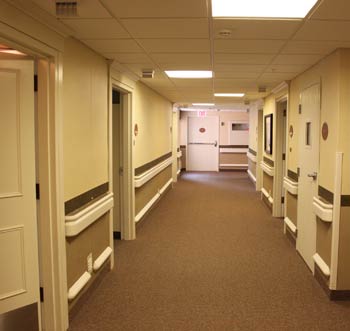
A clean, clutter-free environment
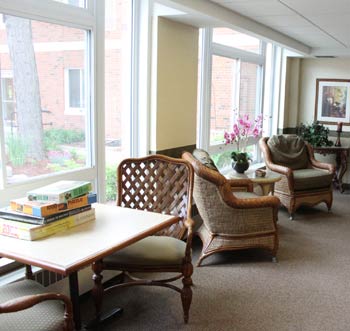
A well-lit environment
Other important nursing home environmental aspects address quality and safety. Issues like clutter, odor, working condition of furniture and equipment, noise, and lighting should be evaluated. Equipment, carts, and the like should not clutter the hallway. There should be no odor at all, such as urine or lingering effects of a meal served several hours ago, as well as intentional positive odors such as sprays used to cover up negative odors. Environmental noise such as overhead paging, phones ringing, and call lights buzzing are very distracting and can contribute to an increase in confused behaviors for people with dementia. Natural light is desired and artificial light should evenly light a room. Minimizing glare is important because older adults are very sensitive to glare. Look at the wheelchairs to determine if they are a fit for the residents’ weight and height and are in good working condition. The cleanliness of the living space is important both from an aesthetic and infection control perspective.
People with dementia, who are both ambulatory and in a wheelchair, may have the need to be mobile on a regular basis. This behavior is often referred to as wandering. Wandering is not a negative behavior and, in fact, is quite purposeful for the individual. The environment should accommodate and support individuals who wander, by ensuring safe places in and outside the home to do so. Many nursing homes have special care units for people with dementia. In addition to providing a safe environment for these residents, the unit is designed to be therapeutically supportive. To learn more about special units and how they should be designed and operated, review these resources developed by state chapters of the Alzheimer’s Association:
Communication
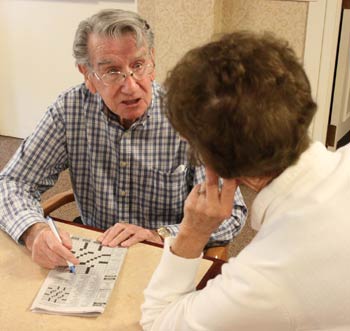
A resident communicating with staff
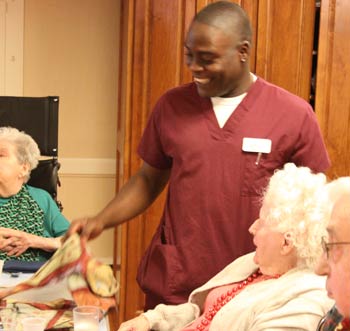
Staff that is friendly with residents
In nursing homes that keep residents as the center and focus of their care, staff are engaged and interact with the residents, even those who have memory issues and problems making daily decisions. Conversations are not about disease and medications, but rather topics of daily life such as the weather, families and friends, and activities and meals. Communication is friendly, with smiling and laughing the norm. In addition to verbal communication, eye contact, smiles, and touch are common. Staff and residents are comfortable and friendly with one another. Most importantly, staff treat residents with respect and maintain residents’ dignity. For example, residents would be taken to bathing rooms fully clothed rather than draped in a blanket and taken to the bathing room in a shower chair.
Care
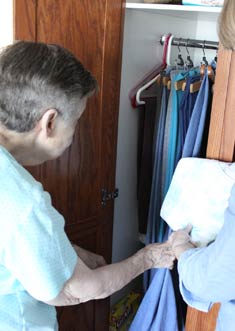
A resident selecting her clothing
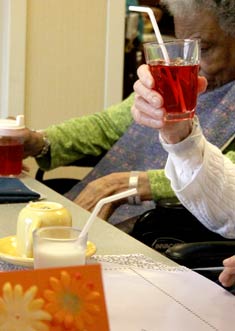
Staff ensuring a resident is receiving fluids

A nurse using evidence-based practice
As just noted, the care for residents would always consider the residents’ dignity and privacy. The great majority of residents need significant assistance with activities of daily living and mobility. But quality care isn’t always ‘doing’ for residents. Rather, it is seeking ways residents can be as independent as possible, which can range from selecting their own clothing and having choices about when and how they want their care, to having them participate in caring for themselves, such as brushing their teeth. Many residents need assistance with eating, but again, staff should enable residents to be as independent as possible. Many residents aren’t able to obtain food and fluids on their own; thus observing how nursing staff make sure residents receive fluids on a regular basis to ensure adequate hydration is another important component of quality care. In addition, staff should provide opportunities for residents to have rest and activity—again according to residents’ preferences and patterns.
Many residents have multiple and complex health conditions that nursing staff need to monitor vigilantly. Quality nursing care involves registered nurses’ ongoing assessment of residents’ clinical conditions, and astute observation of any changes in condition. Another hallmark of quality nursing care is the use of evidence-based nursing assessment and management as the basis of nursing care. In addition to using the required Minimum Data Set to guide the plan of care for residents, there should be evidence that nurses are engaged in comprehensive assessment to fully inform clinical decision making. For example, when determining a residents’ continence status, nurses should be using evidence-based assessment practices to establish the type of urinary incontinence to ensure that nursing interventions are appropriate to treat and manage the resident’s incontinence.
Staff
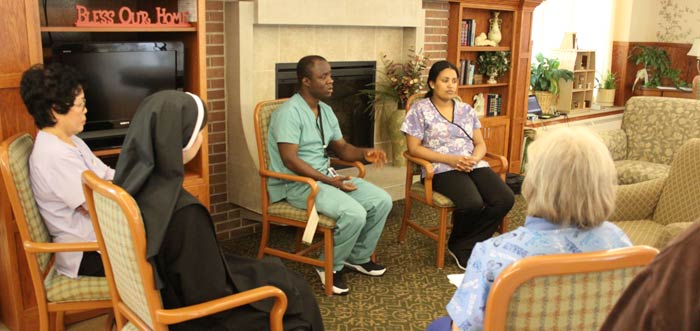
Staff meeting to discuss a resident’s care plan
Staff who attend to the physical and emotional needs of residents 24 hours a day typically are the nursing staff—registered nurses, licensed practical nurses, and nursing assistants. Yet the nursing staff needs the expertise of other staff, such as dieticians, physical therapists, social workers, chaplains, rabbis, and therapeutic recreation specialists, to address residents’ comprehensive needs. These staff, along with nursing, should collaborate and communicate on a regular basis, such as during the quarterly care planning meeting, about the plan of care for each resident.
Family Involvement
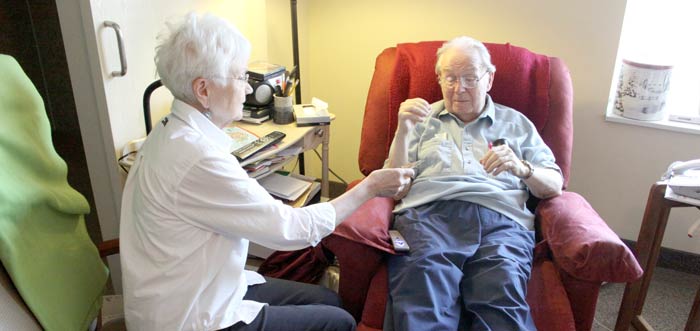
Family visiting a resident
Family Involvement
Family involvement in the life of the nursing home and the care of their loved ones are important hallmarks of a quality nursing facility. The nursing home is really a community in which family plays a significant role. Families should be able to come to the nursing home any time of the day or week. Family members are welcome to hold celebrations at the nursing home such as birthdays. Hosting activities for children, such as games and toys, provides a natural way for children to feel welcome and comfortable in the nursing home.
A nursing home should have a Family Council whereby families have a formal way to provide input into the care and operations of the nursing home. The Family Council is also a mechanism for nursing home staff to formally communicate with families and engage them in the life and activities of the home.
Review these resources to learn more about family councils:
Review the Observable Indicators of Nursing Home Care Quality Instrument (Rantz, et al., 2006) and Guide. Use these tools to guide your visits at nursing homes.
Question for reflection...
How could you use the Observable Indicators of Nursing Home Care Quality Instrument to create a learning experience for students?
Aud, M.A., Rantz, M.J., Zwygart-Stauffacher, M., & Flesner, M. (2006). Measuring quality of care in assisted living: A new tool for providers, consumers, and researchers. Journal of Nursing Care Quality 22(1), 4-7.